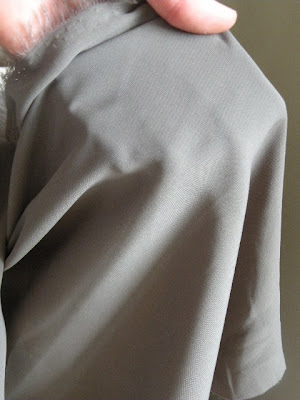I mentioned the slippery fabric which I want to use for my Jasmine blouse. I'm sure you can imagine it shifting all around while I'm trying to cut the pattern pieces out. It would be a nightmare, especially with curved lines. The shape of the finished garment could be ruined.

The question is, how to handle such 'slippery' fabrics? The answer is, you have to stiffen it some way. When I think of stiffly starched fabrics, I think of the old fashioned bonnets of nuns and nurses... or the bonnets of the traditional Dutch folks-wear (You can see a few pretty ones of those
here) And of course, the petticoat-stories of my mum! She used to tell us when she was young in the 60's they didn't have money to buy a really full petticoat and she used to use a lot of starch in order to make the petticoat stand out. When you would put it on a table it would stay upright and won't collapse!
In the US you can buy a starch spray, but I couldn't find it here, so I turned to a natural starch: corn starch! (I really love the 'granny knows' type of good old tricks...) Cornstarch is known from the kitchen, it is used for binding soups and sauces. It is 100% natural, so it won't cause any damage to your fabric. After sewing the garment you can simply wash it out. Here is how to do it!
Important:
- only use it for fabrics that can be washed in warm water! (cotton, synthetic that won't shrink)
- make a muslin from your pattern first, since you can't really see the shape of a garment when sewing since it will be stiffened!
You need:
- corn starch
- cold water

1. Combine cornstarch and water, mix until smooth. I used 4 good tablespoons for 1 liters of water. The water will turn a bit milky:

2. Cook over medium heat stirring until it gets thick and starts to shift a bit. It gets translucent, reminded me to wallpaper glue:

3. Solve the mixture in more water (I used 2 more liters) and rinse your fabric:

4. Hang the fabric somewhere where you can hang it
evenly. This is really important because you don't want the fabric grain to shift! Once it is dry and stiff you can't really correct this. Press after drying:

And the result is with starch (left) without starch (right):


Once your garment is ready, wash it as usual in warm water, this will solve the cornstarch. (Actually the picture above is also an 'after-starch' picture.)
Let's start sewing!

































